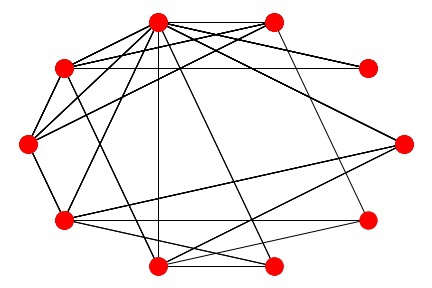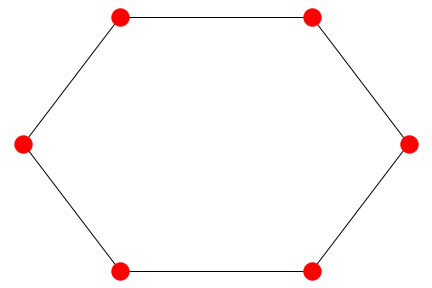[Python]利用python实现复杂网络的博弈(0)——Introduction
Evolutionary Gaming Theory(EGT), 演化博弈,或曰,进化博弈。顾名思义,演化博弈同传统博弈的不同之处就在于,其模仿了类似于生物进化的形式。在一个达尔文式的框架之下,参与博弈的节点通过给定的规则竞争,然后根据结果改变自身的策略。与传统的博弈论不同的是,这里,参加博弈的双方不再是被认为具有超级理性的个体,而是在不断的试错、评估中,动态的调整自己的策略
本次博弈,我们将会尝试构建(指直接调用别人写的库)一个复杂的随机网络,该网络具有两种不同的节点,他们会按照一定的概率选择“分享”与“不分享”两种策略。每个节点会与图中所有的其他节点博弈,计算其收益,并依照一定的概率改变其策略,改变其初值,并查看最终的演变情况与稳定状态。
Reference :EGT的wiki或者百度百科
关于Networkxnetworkx是一个python包,用于创建、操作和研究复杂网络的结构、动态和功能.NetworkX出生于2002年5月。最初的版本是由AricHagberg、DanSchult和PieterSwart在2002年和2003年设计和编写的。第一次公开发布是在2005年4月。
NetworkX提供:
研究社会、生物和基础设施网络结构和动态的工具; 一种适用于多种应用的标准编程接口和图形实现; 为协作性、多学科项目提供快速发展环境; 与现有的数值算法和C、C++和FORTRAN代码的接口; 能够轻松处理大型非标准数据集。Networkx的相关知识将在下一篇文章里面讲解。
Reference:官方文档
什么是无标度网络?Scale-free network, 无标度网络。在很多实际模型抽象出的网络当中,节点之间节点度的分布是不均匀的,是依照幂率分布的。少数节点连接着大多数的点,而大多数节点只与很少的点连接。如果用公式描述的话,则是:P(k)∼k−γP(k) \sim k^{-\gamma}P(k)∼k−γ 。意即:在网络中,节点度为kkk 的点所占的比例大致服从k−γk^{-\gamma}k−γ,其中γ\gammaγ的取值大致为2~3之间。不过,关于无标度网络的具体数学特性,学界仍有争论(参考)。
Reference:无标度网络的wiki或者百度百科
无标度网络最为经典的生成算法是Barabási-Albert算法,其大致的内容为:
1.增长:从一个具有 m0m_0m0 个节点的联通网络开始,每次引入一个新的节点, 并且连到 mmm 个已经存在的节点上,这里 m<=m0m <= m_0m<=m0。
2.优先连接:一个新的节点与一个已经存在的节点 iii 相连的概率 www 与节点 iii 的度 kik_iki 之间的关系为 w=ki/(k1+k2+k3+...+kn)w = k_i / ( k_1 + k_2 + k_3 + ... + k_n )w=ki/(k1+k2+k3+...+kn),其中nnn为网络中的节点的总个数。
Reference :BA无标度网络模型构造算法
其在networkx中的源码为:
def barabasi_albert_graph(n, m, seed=None):
"""Returns a random graph according to the Barabási–Albert preferential
attachment model.
A graph of ``n`` nodes is grown by attaching new nodes each with ``m``
edges that are preferentially attached to existing nodes with high degree.
Parameters
----------
n : int
Number of nodes
m : int
Number of edges to attach from a new node to existing nodes
seed : int, optional
Seed for random number generator (default=None).
Returns
-------
G : Graph
Raises
------
NetworkXError
If ``m`` does not satisfy ``1 <= m < n``.
References
----------
.. [1] A. L. Barabási and R. Albert "Emergence of scaling in
random networks", Science 286, pp 509-512, 1999.
"""
if m =n:
raise nx.NetworkXError("Barabási–Albert network must have m >= 1"
" and m < n, m = %d, n = %d" % (m, n))
if seed is not None:
random.seed(seed)
# Add m initial nodes (m0 in barabasi-speak)
G=empty_graph(m)
G.name="barabasi_albert_graph(%s,%s)"%(n,m)
# Target nodes for new edges
targets=list(range(m))
# List of existing nodes, with nodes repeated once for each adjacent edge
repeated_nodes=[]
# Start adding the other n-m nodes. The first node is m.
source=m
while source<n:
# Add edges to m nodes from the source.
G.add_edges_from(zip([source]*m,targets))
# Add one node to the list for each new edge just created.
repeated_nodes.extend(targets)
# And the new node "source" has m edges to add to the list.
repeated_nodes.extend([source]*m)
# Now choose m unique nodes from the existing nodes
# Pick uniformly from repeated_nodes (preferential attachement)
targets = _random_subset(repeated_nodes,m)
source += 1
return G
这个算法使用了一个tricky的手段来完成了ba算法对于概率的要求。变量repeated_nodes其中实际上存储了所有边的两个端点(重复也会算进去),然后在repeated_nodes里面随机选择,这样每个节点被选中的概率与其度数相关。
在这个算法里面,参数mmm实际上和图的平均节点度存在一定的关系。具体可以参考给定平均链接度的无标度网络演化模型,结论是经历足够长的时间(也就是总结点数趋近于无穷时),平均节点度为2m2m2m ,实际上,平均节点度会小于这个值
无标度网络的生成过程(参数为10, 3。该gif使用python生成,参考了IT派森的使用Python将多个png图片转为gif):

"Small-world" network,小世界网络。在现实生活中,我们不一定是彼此的邻居,但是往往通过很少的步数,就可以到达彼此。 描述小世界网络有两个重要的参数:
特征路径长度(characteristic path length or typical distance) : 我们将任意两个点到达彼此的最短距离称作两点间的路径长度,所有点的组合便被称作图的特征路径长度,记作LLL,其与图的总结点数NNN服从如下数学关系:L∝logNL \propto logNL∝logN 聚合系数(clustering coefficient):这个其实是在图论里面的概念。对于一个节点nnn,如果有kkk个节点与他相连,那么这kkk个与其相连的节点组成的子图所具有的边数,与大小为kkk的完全图所含的边数(即为(k−1)k/2(k - 1)k/ 2(k−1)k/2)之比即为该点的聚合系数,所有点的聚合系数之均值便为该图的聚合系数。小世界网络的聚合系数一般不小。Reference:小世界网络的Wiki和百度百科
小世界网络中最为经典的生成算法是Watts-Strogatz算法,其大致的内容为:
1.初始化,首先创建一个具有nnn个节点的环状图。每个节点均与其最临近的kkk(kkk必须为偶数)个点相连,均匀分布于两侧
2.重新连接,对于每个边,其中一个随机端点依照ppp的概率取消这个链接,并重连至另外一个随机端点
其在networkx中的源码为:
def watts_strogatz_graph(n, k, p, seed=None):
"""Return a Watts–Strogatz small-world graph.
Parameters
----------
n : int
The number of nodes
k : int
Each node is joined with its ``k`` nearest neighbors in a ring
topology.
p : float
The probability of rewiring each edge
seed : int, optional
Seed for random number generator (default=None)
See Also
--------
newman_watts_strogatz_graph()
connected_watts_strogatz_graph()
Notes
-----
First create a ring over ``n`` nodes. Then each node in the ring is joined
to its ``k`` nearest neighbors (or ``k - 1`` neighbors if ``k`` is odd).
Then shortcuts are created by replacing some edges as follows: for each
edge ``(u, v)`` in the underlying "``n``-ring with ``k`` nearest neighbors"
with probability ``p`` replace it with a new edge ``(u, w)`` with uniformly
random choice of existing node ``w``.
In contrast with :func:`newman_watts_strogatz_graph`, the random rewiring
does not increase the number of edges. The rewired graph is not guaranteed
to be connected as in :func:`connected_watts_strogatz_graph`.
References
----------
.. [1] Duncan J. Watts and Steven H. Strogatz,
Collective dynamics of small-world networks,
Nature, 393, pp. 440--442, 1998.
"""
if k>=n:
raise nx.NetworkXError("k>=n, choose smaller k or larger n")
if seed is not None:
random.seed(seed)
G = nx.Graph()
G.name="watts_strogatz_graph(%s,%s,%s)"%(n,k,p)
nodes = list(range(n)) # nodes are labeled 0 to n-1
# connect each node to k/2 neighbors
for j in range(1, k // 2+1):
targets = nodes[j:] + nodes[0:j] # first j nodes are now last in list
G.add_edges_from(zip(nodes,targets))
# rewire edges from each node
# loop over all nodes in order (label) and neighbors in order (distance)
# no self loops or multiple edges allowed
for j in range(1, k // 2+1): # outer loop is neighbors
targets = nodes[j:] + nodes[0:j] # first j nodes are now last in list
# inner loop in node order
for u,v in zip(nodes,targets):
if random.random() = n-1:
break # skip this rewiring
else:
G.remove_edge(u,v)
G.add_edge(u,w)
return G
这个算法对于图,使用了添加边的方式来初始化,向里面添加[(1,2), (2, 3), .....][(1,3),(2,4),.....]...来完成初始化。之后以同样的方式开始遍历每个边,进行重连。
他的平均节点度就是kkk,但是一定是一个偶数。
一个小世界网络的生成过程(参数为6, 4, 0.8):

作者:Span_1024